Kimberly Nicholas's Blog
September 9, 2025
Happy Launch Day, SHIFT! 🚀🌎
Hi friends,
I’m interrupting my usual monthly publishing schedule for some VERY EXCITING BREAKING NEWS I just couldn’t wait to tell you!
Today, in partnership with the amazing team at Project Drawdown, I’m launching a personalized, research-backed guide to meaningful climate action that really makes a difference.
The Super High-Impact Initiative for Fixing Tomorrow (SHIFT) guide starts from where YOU are, and identifies your unique climate superpowers.
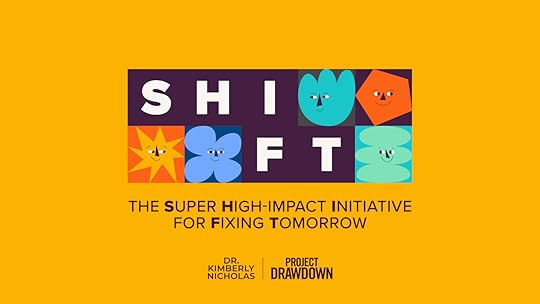
SHIFT distills the evidence down to specific actions you can take as a citizen, professional, investor, consumer, and role model (represented by these adorable little ambassadors below). Then we’ll give you the tools you need to take these actions in your real life. (And of course, linked references for my fellow nerds to nerd out over! 🤓)
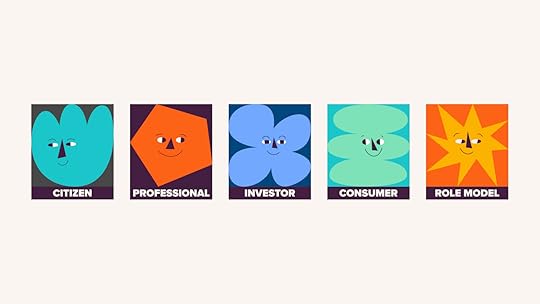
Loyal readers may remember a beta version of this guide I launched in this newsletter last year. Thanks so much to those who gave feedback. 💚
Take me to the SHIFT guide now!
We’ve taken your feedback to heart and used it to redesign and improve the guide throughout. Including adding the most-requested feature: a downloadable PDF checklist you can come back to, share, post on your fridge and cross off items one by one with a great feeling of satisfaction… you get the idea!
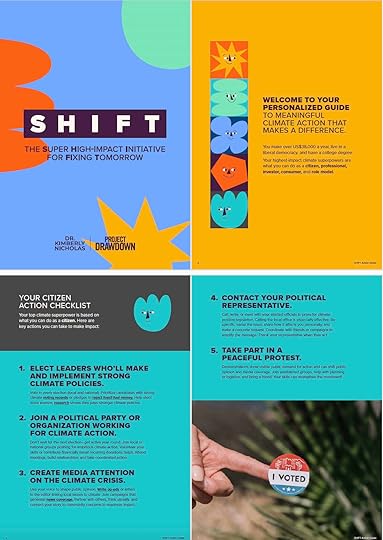 Sneak peek of the SHIFT downloadable climate action guide cheat sheet. You’ll have to take the quiz at jointheshift.earth to get your personalized copy!
Sneak peek of the SHIFT downloadable climate action guide cheat sheet. You’ll have to take the quiz at jointheshift.earth to get your personalized copy! I’m so happy I got the chance to work with the fabulous team of scientists, strategists, communicators, and project managers at Drawdown, and a wonderful creative team at Leap who brought SHIFT to life. We’ve poured a lot of love, brainstorming, strategy, research, writing, editing, fact-checking, testing, and revising into SHIFT.
Now please — go to jointheshift.earth to check it out, make it your own, and most importantly, take the recommended high-impact climate actions where you can make the biggest difference!
Then, please share SHIFT with a friend, colleague, neighbor... Or three.
I’m excited to see how you #MakeSHIFThappen in the world! Please share in the comments here, or using that hashtag on social media.
Happy climate action!
xo,
Kim
I'm ready to SHIFT climate action!
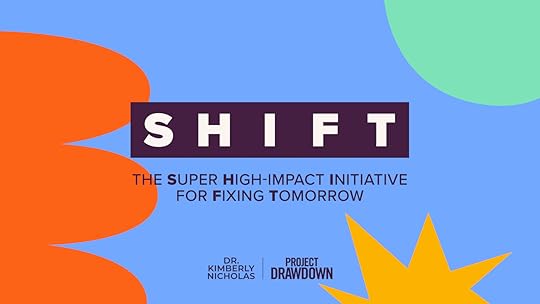
P.S. I’d love to see you at the webinar next week where I’ll chat with Dr. Elizabeth Bagley from Project Drawdown on the behind-the-scenes creation of SHIFT, and how you can use this guide to find and start flexing your climate superpowers. Register here!
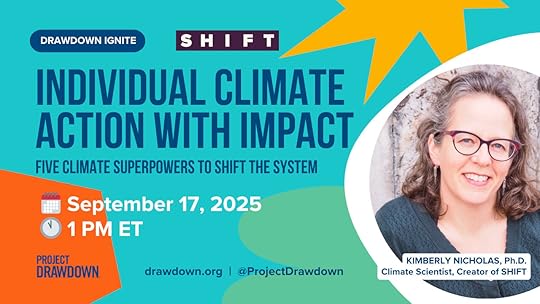
August 28, 2025
Join a beautiful revolution
Welcome to We Can Fix It, where we face the climate crisis with facts, feelings, and action. Written by me, climate scientist Kim Nicholas.
Hi friends,
Back to school vibes! The students arrive this week, and I start teaching my new course, Climate Science and Politics, next week. It’s a rocket start after a beautiful summer. Installing the electric motor (and 90kg of batteries) on our 50-year-old sailboat was WAY more work than I expected. But we figured it out! It works great! And Simon and I loved living on the boat for 10 days, circumnavigating the Öresund. Building up to that dream of the Atlantic crossing one step at a time…
This month, I have some Good Climate News for you! Plus, making room for the sadness (and All the Climate Feels), and encouragement to join a beautiful revolution near you.
Facts: Countries legally responsible for climate harmDid you catch this huge piece of good climate news over the summer?
A landmark, unanimous advisory opinion by the International Court of Justice found states are legally obligated to cut climate pollution, and may be held legally liable if they fail to do so.
This was a HUGE victory for the campaign started in 2019 by 27 law students from Pacific Island countries. 👏👏👏 Amazing work! 👏👏👏
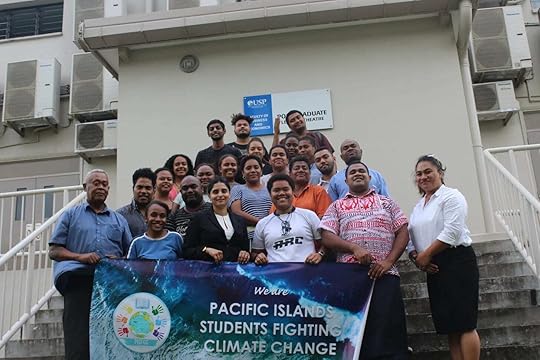 The team at Pacific Island Students Fighting Climate Change, whose 2019 campaign led to the International Court of Justice decision in July 2025. BRAVO!! Yay science!
The team at Pacific Island Students Fighting Climate Change, whose 2019 campaign led to the International Court of Justice decision in July 2025. BRAVO!! Yay science! The court built heavily on science, especially the reports from the Big Bad Mothership of Climate Facts, or the Intergovernmental Panel on Climate Change (IPCC) (refresher on who they are). As Carbon Brief reported, judges in the case also arranged a meeting with IPCC scientists.
Thank you, scientists, for writing and compiling scientific papers, and for the flood of written and oral statements that were submitted to the court to inform their opinion!
2 big findings from the legal opinion 1. States have “binding obligations to ensure the protection of the climate system”The courts found “states have a duty to prevent significant harm to the environment”, requiring them to act with “due diligence” and use “all means at their disposal” to prevent climate harm. As Carbon Brief reported,
The court sets out the “appropriate measures” that would demonstrate due diligence, including “regulatory mechanisms…designed to achieve deep, rapid and sustained reductions” in emissions. This repeats language from the IPCC, but attaches it to countries’ legal obligations.
I love to see an IPCC quote I use on my slides in teaching show up in court! But that’s not all…
2. If states harm the climate or environment, they can be held accountableIf states do cause significant climate harm, from too-weak international climate pledges or national regulations, the court says it’s feasible to hold specific states responsible for climate damages on a case-by-case basis.
“Failure of a State to take appropriate action to protect the climate system from greenhouse gas emissions — including through fossil fuel production, fossil fuel consumption, the granting of fossil fuel exploration licences or the provision of fossil fuel subsidies — may constitute an internationally wrongful act which is attributable to that State.”
-International Court of Justice, July 2025
Got that?? States may be held liable for their excessive fossil fuel production, consumption, and subsidies!!
A court might order a country to make a climate pledge in line with its Paris obligations, or allow nations and “injured individuals” to seek “reparations” for climate damage.
The takeawayMega-polluting countries have long feared having to pay for the harms their climate pollution has caused. This opinion is a powerful new tool to hold governments accountable. I’m excited to see where it will lead!
Feelings: “Make room for the sadness”My family in Sonoma, California evacuated from wildfire in 2017. I was afraid we’d have to in 2020, when I was home on an emergency visit when my hospitalized father got Covid in that scary first summer of the pandemic.
Thankfully my family was safe. But since I experienced the shattering disorientation of a grey sky and an orange sun, I don’t take blue-sky summers for granted.
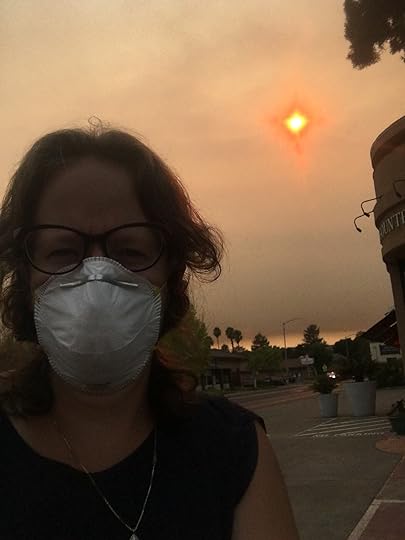 Me + smoky skies in my hometown of Sonoma, California in August 2020.
Me + smoky skies in my hometown of Sonoma, California in August 2020. As more and more of us experience the terror and grief of warming-worsened wildfires, this post from the wise Dr. Elizabeth Sawin stopped me in my tracks. With her permission, I’m sharing it with you:
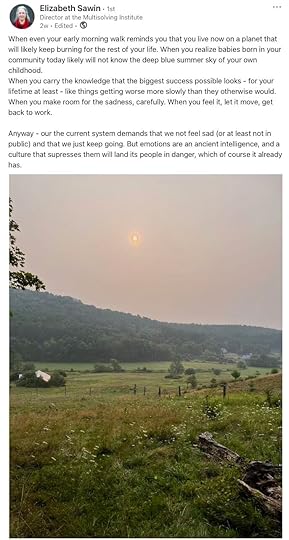 Source: LinkedIn post by Elizabeth Sawin, shared with permission.
Source: LinkedIn post by Elizabeth Sawin, shared with permission. I’m grateful for people like Beth who are naming and making space for All the Climate Feels. It’s good to know we are walking this tough path in company, don’t you think?
Action: Join a Beautiful RevolutionLast weekend, I joined hundreds of people singing, dancing, knitting, sharing poetry and children’s books, speaking, sitting, sleeping, marching, and peacefully demonstrating for a safe climate together, through rain and shine.
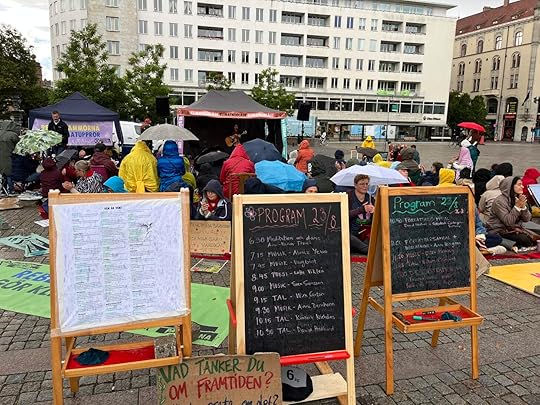 A packed, fun program for the Mother’s Rebellion 24-hour climate protest in Malmö, Sweden. Members sit in a circle facing the public, inviting connection.
A packed, fun program for the Mother’s Rebellion 24-hour climate protest in Malmö, Sweden. Members sit in a circle facing the public, inviting connection. The Rebellmammorna (Rebel Mammas) led 24 beautiful hours of climate action in a busy central square in Malmö, Sweden.
It was a delight to be part of. As soon as I showed up, I was offered a cookie!
Grandmas were sitting in cozy armchairs, knitting away (part of the Knitting for Climate movement).
I gave a talk thanking the demonstrators for being out on the streets, and why it makes a difference:
My first climate protestIf you’ve never been to a climate protest before, I get it. It feels like a big step to take. I was in your shoes, as I wrote about in Under the Sky We Make, pondering joining my first protest in 2014:
Protests work!
“I’m a scientist, not an activist,” I thought to myself. I had never been to a protest or marched in the streets for anything, and it sounded a bit . . . weird? Silly? Vulnerable?
Then I read an article that changed my mind. (I’ve looked for it and can’t find it, so that author will never know they inspired me!) Basically, it said, what if this was the thing that made the difference? There’s no way to know beforehand, and you’ll probably never know afterward either, but what if this is the start of the tipping point? “Okay,” I thought. “I’ll go.”
I sat at my kitchen table with a piece of poster board and colorful markers and pondered what to put on my sign. I ended up making a footnoted protest sign summarizing the science, with references: It’s warming. It’s us. We’re sure. It’s bad. We can fix it.
Now it’s your turn. Climate demonstrations are fun and energizing, they build joy and community, and they work.
If you’re among the lucky 12% of people globally who live in a liberal democracy, according to the Varieties of Democracies Project, then your most powerful climate superpower is your actions as a citizen. And peaceful protests are among your most effective citizen actions.
Peaceful protests have been shown to increase climate support, including favorable shifts in climate media coverage and public opinion. One study found increased climate protests were associated with declines in emissions in US states. Plus, joining demonstrations is a great way to meet people with the same goals as you.
How to get involvedYour high-impact action this month is to find a local group you can join and support in climate demonstrations.It's most effective to start with an existing organization. There is one near you that would love your support!
Find the next meeting of your group, put it in your calendar, and show up! Bonus points if you bring a friend.
Your talents are needed – whether it's designing materials, building coalitions, showing up for the big day of action, updating websites, providing childcare, accounting... movements need it all!
A great place to start, with tons of chapters globally and lots of great resources for becoming a more savvy activist, is 350.org.
Actions in September 2025350.org is co-organizing a week of action during the United Nations General Assembly, where world leaders gather in New York City.
Their Draw the Line campaign demands an equitable and just transition to phase out fossil fuels, build renewables, and shift to sustainable food.
You can find a local action for Draw the Line in cities like New York, Edmonton, Vancouver, Berlin, London, Paris, Wellington, Melbourne, Belém, Johannesburg, Dhaka, Tokyo, and more… or get support to organize your own.
In Sweden, there are climate demonstrations being organized in Stockholm for September 9 (when parliament re-opens), and Gothenburg on September 13 (one year before our next national election).
Join one of these actions, or find one near you!
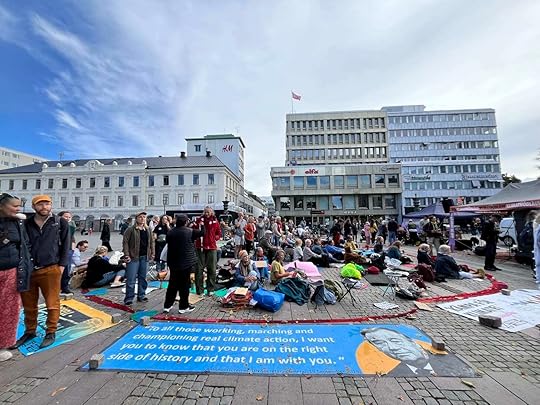 UN Secretary-General António Guterres says we’re on the right side of history and he’s with us! Photo: meParting Tidbits Upcoming talks, come see me here
UN Secretary-General António Guterres says we’re on the right side of history and he’s with us! Photo: meParting Tidbits Upcoming talks, come see me hereWednesday, September 17, 10am Pacific/1pm Eastern/19h Sweden: Drawdown Ignite webinar: Individual Climate Action with Impact: Five Climate Superpowers to SHIFT the System. I’m VERY excited to share the launch of The Super High-Impact Initiative for Fixing Tomorrow (SHIFT). I’ve been working on this for four years, and in the last year collaborating with an amazing team at Project Drawdown who has brought it to life beyond my dreams. Right here is the first public announcement — join us for the guide that helps people understand their power, and then prioritize climate actions that punch above their weight.
Friday, September 26, 13:15-17:00, Lund, Sweden: Celebrating 25 years with LUCSUS. Come hear about the past, present, and future of sustainability science research and teaching. I’ll moderate the panel, and I promise it will be lively!
Book RecommendationThe Serviceberry: Abundance and Reciprocity in the Natural World, by Robin Wall Kimmerer. This short book, more like an extended essay, is a quiet and lovely meditation on the world that’s possible if we can learn to live in peace with nature. Kimmerer writes about embracing reciprocity as a way of “keeping nature’s gifts in motion,” taking care of the gift so it can keep on giving. “Recognizing ‘enoughness’ is a radical act in an economy that is always urging us to consume more.” You can see my highlights on Goodreads.
Thanks for reading!
xo,
Kim
P.S. I’d love to hear your climate dilemmas and triumphs, please feel free to send me a voice note!
This post is free to make climate action accessible to everyone. Please subscribe to receive new posts. If you find my work valuable and are financially able, I am grateful for any support you can give as a paid subscriber.
June 26, 2025
Build Effective Collective Climate Action
Welcome to We Can Fix It, where we face the climate crisis with facts, feelings, and action. Written by me, climate scientist Kim Nicholas.
Hi friends,
It’s summer! That time of year when Swedes try to absorb a whole year’s worth of sunshine in a few weeks. Simon and I will soon be joining them, taking off on our sailboat for parts unknown as soon as our New Electric Motor arrives from Germany! That means you won’t hear from me here in July, but if you want to follow our adventures, you can check out .
But I’m getting ahead of myself— first, let’s talk about building effective collective action, resting in the grace of the world, and banning fossil advertising.
Facts: How to build effective collective climate actionThe Psychology of Collective Climate Action has excellent insights for building and sustaining effective, resilient collective climate action.
I’ll share some highlights below; I highly recommend reading this new book!
What is collective climate action?The authors start with a clear definition, which always warms my heart:
“Collective climate action is when individuals act as members of a group with the aim of changing socio-political structures in the face of the climate crisis.”
- Karen Hamann, Eva Junge, Paula Blumenschein, Sophia Dasch, Alex Wernke and Julian Bleh, 2025, The Psychology of Collective Climate Action: Building Climate Courage
Collective action goes beyond the private sphere. It can be volunteering for an environmental group, attending protests, writing your local government officials, or pushing for change at work or school.
How does collective action happen?The book builds on the Social Identity Model of Collective Action, from a meta-analysis that found injustice, identity, and efficacy (the belief you can reach your intended goals) drove people to collective action.
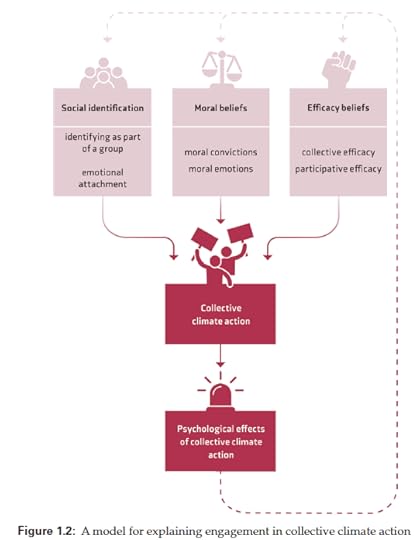 More specifically for climate action, Hamman and colleagues posit that identifying as part of a group, drawing on moral beliefs, and a belief in your collective efficacy drives people to collective climate action. Source: Hamann et al., 2025, The Psychology of Collective Climate ActionHow to increase effective collective climate action? To strengthen collective climate action, strengthen its component pieces in the social identity model. Specifically, Hamman et al. recommend: Social identification:
More specifically for climate action, Hamman and colleagues posit that identifying as part of a group, drawing on moral beliefs, and a belief in your collective efficacy drives people to collective climate action. Source: Hamann et al., 2025, The Psychology of Collective Climate ActionHow to increase effective collective climate action? To strengthen collective climate action, strengthen its component pieces in the social identity model. Specifically, Hamman et al. recommend: Social identification: Build a shared understanding of what the group stands for
Cultivate solidarity
Have experiences together
Create situations where many people join climate action
Have fun!
Moral beliefs:Reflect on values
Draw attention to injustices
Talk about outrage
Consider a radical flank.
Efficacy beliefs:Highlight success
Share in credit for success
Set a small number of diverse goals
Support each other in developing and using skills
Give appreciative feedback to others
“Design collective climate actions that inspire people and make them feel enthusiastic, hopeful, proud, and moved.”
To make climate action resilient and effective:Collective action:
Pick your battles
Participate in collective climate action, which can foster motivation.
Psychological effects:Actively maintain personal and group resilience to avoid burnout.
Ensure belonging
Celebrate success
Cultivate efficacy
Establish a process to handle conflict and infighting
Make time for fun
Spread tasks and trust others
Take breaks.
Makes a lot of sense, right?? How can you apply these tips to climate groups you’re already a part of? Let me know in the comments below. And keep reading for a fantastic way to put these insights to use in a high-impact local campaign!
Feelings: “Rest in the grace of the world”My sister recently sent me this Wendell Berry poem.
I’d read and loved it before, but it really struck me this time.
I am someone prone to “tax my life with the forethought of grief.” This poem was such a beautiful reminder to find and appreciate the peace of wild things and places, even amidst despair for the world. <3
 Image source: Scottish Poetry Library
Image source: Scottish Poetry LibraryP.S. Watch this lovely <2 minute poetry film by Charlotte Ager & Katy Wang, while Wendell Barry reads his poem for you, from the .
Action: Lobby Your City to Ban Fossil AdsReady to put your collective climate action to work?
Well, how would you like to do something that, according to a recent Nature Climate Change comment:
Counteracts decades of disinformation, denial, and delay from the fossil fuel industry, and weakens their moral license
Fights greenwashing
Shows that bold climate policies are possible, and legislators have a mandate to enact them
Can succeed even in places ruled by powerful corporate interests and seats of right-wing populist power
Enjoys twice as much support as opposition across 13 EU countries, suggesting limited potential backlash, and does not restrain consumer “freedom”
Help unlock the climate transformation we need, by weakening the dominant, unsustainable system and creating space for sustainable alternatives
Creates, supports, and normalizes a low-carbon culture, which can break carbon lock-in
Reduces the cognitive dissonance of living in a world where high-carbon business as usual goes on amidst a climate emergency 🫠
Sounds pretty good, right?? Then your action this month is to….
Join or start a group to lobby your city to ban fossil fuel ads in public spacesThe Hague, city of over half a million people in The Netherlands, has already done it. In January 2025, the city became the world’s first to implement a law that prohibits advertisements for fossil fuel products and services in public spaces. No more ads for gasoline (petrol), diesel, flying, cars with internal combustion engines, contracts for fossil-based electricity, or cruises.
And they managed to enact this ban in a city that’s a major corporate base for that non-friend of climate action, Shell, and seat of national government where the anti-climate, right-wing populist party got the most votes in the last election.
AND they’ve recently won a court case, upholding the ban!
How did The Hague ban fossil ads?They followed science. In 2023, a group of Dutch academics issued a government report “A Ban on Fossil Advertising: Essential but More is Needed.” Thijs Bouman and coauthors wrote about the process and what it means in a Nature Climate Change comment, which is how I heard about it.
They followed growing political support, including from United Nations Secretary-General António Guterres, who said in a 2024 speech:
“Many in the fossil fuel industry have shamelessly greenwashed, even as they have sought to delay climate action – with lobbying, legal threats, and massive ad campaigns.
Many governments restrict or prohibit advertising for products that harm human health – like tobacco.
Some are now doing the same with fossil fuels.
I urge every country to ban advertising from fossil fuel companies.
And I urge news media and tech companies to stop taking fossil fuel advertising.”
—United Nations Secretary-General António Guterres
They organized support from local groups to ban fossil fuel advertising and coalitions of academics, creatives, finance, politics and activists to create a social tipping point towards a sustainable new normal.
How can YOU ban fossil ads?Lucky for us, World Without Fossil Ads has a step by step toolkit for what to do! Huge shout-out to the group Fossil Free Advertising that developed this guide and helped support the win in The Hague. See their great overview below and check out their resources to put a fossil ad ban in motion in your town!
 Source: Step by Step Guide from World Without Fossil Ads
Source: Step by Step Guide from World Without Fossil Ads You can also:
Check the World Without Fossil Ads database of over 250 initiatives to ban fossil advertising. You can be inspired by recent wins like Zurich removing digital ad screens in public and see campaigns involving doctors, schools, banks, and more.
Read up on the research providing evidence that fossil advertising helps sustain high emissions, summarized in 2 pages (+18 pages of footnotes, <3) for municipal or national ad bans.
Thanks for reading! Please share this post with a friend to spread climate action.
At your next climate group meeting, suggest you take up this campaign— or invite some friends over for a backyard BBQ and get them fired up to join you!
Parting Tidbits Upcoming talks, come see me here:Speaking of collective action from effective climate groups— I’ll be joining the Rebel Mammas at their 24 hour climate protest in Gustav Adolfs Torg, Malmö. I’ll be there from 08:00-noon on Saturday, August 23, and giving a speech around 11. Please join us!
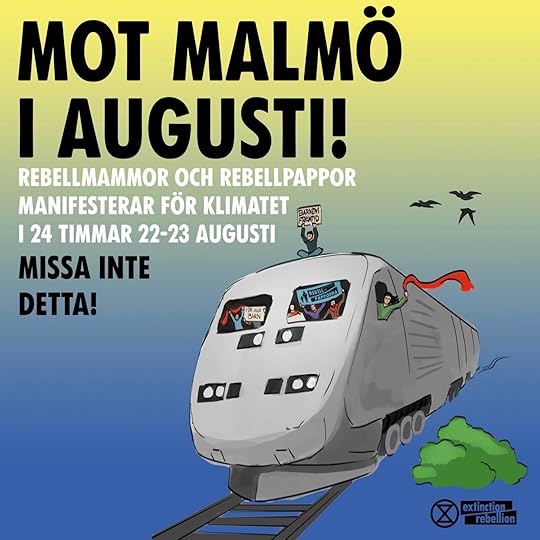 Source: Rebelmammor och RebellpapporBook Recommendation
Source: Rebelmammor och RebellpapporBook RecommendationThe Psychology of Collective Climate Action - Building Climate Courage. By Karen Hamann, Eva Junge, Paula Blumenschein, Sophia Dasch, Alex Wernke, and Julian Bleh. Clear, accessible, short but well-referenced chapters full of practical advice for creating and sustaining effective and resilient climate groups that can make real change happen. Read it at your next climate group meeting, or use it as the basis to start your own group!
Podcast RecommendationFunny and kickass podcast w/ Kate Marvel on her new book Human Nature: Nine Ways to Feel About Our Changing Planet. Hooray for climate scientists embracing All the Climate Feels!
Thanks for reading!
xo,
Kim
P.S. Thank you SOOO MUCH to those of you who left me a voicemail about your climate questions, successes and dilemmas. I LOVED hearing from you! I will get back to you after summer as I put the podcast together— please stay tuned!
And I’d love to hear from more of you, please feel free to send me a voice note!
This post is free to make climate action accessible to everyone. Please subscribe to receive new posts. If you find my work valuable and are financially able, I am grateful for any support you can give as a paid subscriber.
May 30, 2025
Send me a voice note!
Welcome to We Can Fix It, where we tackle the climate crisis with facts, feelings, and action. Written by me, climate scientist Kim Nicholas.
Hi friends,
Greetings from the train to Paris! I have work there next week, and on the way, Simon and I are taking advantage of the Swedish holiday weekend to see where my parents lived in Heidelberg when they were first married, and try their all-time favorite restaurant (no pressure!!).
This month, we’ll look at ways to grow better through struggling with crisis; and I’ll ask you to send me your burning climate questions by voice note, so I can answer them on my new podcast!
Action: Send Me Your Climate Dilemma(& you might end up on my new podcast!)This month, your high-impact climate action is to send me a voice note. 💚
Specifically, a voice note asking for advice on a climate dilemma you’re facing. I’ll try my best to answer your question on a new podcast I’m working on.
The first podcast season will focus on the highest-impact actions within your Five Climate Superpowers:
1. Citizen: Elect climate championsFed up with climate laggards in office in your town/region/country? Or have a success story to share about getting a climate champion elected?
2. Professional: Cut workplace emissions in half by 2030Does your workplace have climate goals in line with science? More importantly, are they following them? How would you even know what’s legit??
3. Investor: Switch to a fossil-free bankHave you managed to move your money out of the big bad banks? Or have inertia, bureaucracy, and logistics gotten in the way?
4. Consumer: Let go of frequent flyingPeople find this one of the hardest actions. Where are you at with flying less (or going flight-free)? Ready to try to get started? Or were you surprised by anything when you skipped a flight?
5. Role model: Build a strong climate communityAre you feeling alone in the climate crisis, or do you have a strong, fun group of Climate People around you? Have questions on finding your peeps, or tips on what worked?
In your voice memo about one of the above areas, please let me know:
Where are you eager to take climate action but feel stuck? Tell me why.
Where have you tried to take climate action and ran into roadblocks? What happened?
What climate action success stories can you share to help others?
Share your question with me by clicking here:
Thanks so much for sharing, I’m excited to hear from you!!
Facts + Feelings: Better after Crisis?What if things could be better on the other side of major crisis? Not just “bouncing back” to the same old baseline, but “bouncing forward” to a new and more meaningful way of being?
This is the idea of posttraumatic growth. It’s been around psychology for decades, and I think it offers important lessons in the climate crisis.
Growth can result from “the potentially transformative power of suffering” if:
A major crisis breaks your core beliefs.
In response, you can ruminate, cope, or struggle.
Through struggle, especially with support, you can achieve positive transformation.
Posttraumatic growth can help you function better than you did before, with more focus on what really matters.
It starts with crisisThe process of posttraumatic growth involves a “seismic event,” a crisis big enough to disrupt core beliefs and “shatter the individual’s understanding of the world and [their] place in it,” as psychologists Richard Tedeschi and Lawrence Calhoun wrote.
Core beliefs help us understand the way the world works, guide our decisions, and provide meaning and purpose. Cracking them is deeply distressing.
Response to crisisFrom this shattered foundation, there are three options:
Anxious, repetitive thoughts: a natural response to the crisis, but can be paralyzing and lead to a decline in function (the opposite of growth).
Coping: using strategies to “bounce back” to the previous baseline. This is sometimes called resilience. It implies recovery, but no growth.
Struggle, which can lead to posttraumatic growth.
Note that growth is not inevitable, but it is possible in response to crisis. Tedeschi and Calhoun speculate perhaps people with the highest coping capacity might experience little growth, because they don’t struggle enough!
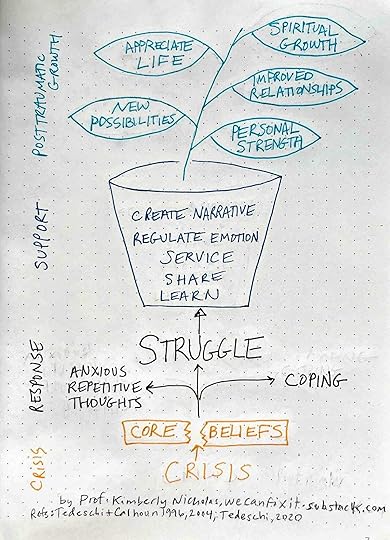 A crisis that shatters core beliefs can cause struggle, which with support, can lead to posttraumatic growth. Figure: drawn by me on a train! Refs: Tedeschi + Calhoun 1996; 2004; Tedeschi, 2020Paths to support growth
A crisis that shatters core beliefs can cause struggle, which with support, can lead to posttraumatic growth. Figure: drawn by me on a train! Refs: Tedeschi + Calhoun 1996; 2004; Tedeschi, 2020Paths to support growth More recently, Tedeschi wrote in Harvard Business Review about five ways leaders can help others achieve growth following crisis. Slightly reworded, they are:
Learn: face the truth of the trauma and rethink identity, worldviews, and future plans.
Share: make sense of the trauma by talking about what’s happened, its effects, and your struggles and concerns.
Service: “people do better in the aftermath of trauma if they find work that benefits others”.
Regulate emotions: tolerate uncertainty, observe and acknowledge difficult emotions, and use practices like movement and mindfulness to increase agency.
Create narrative: Develop an authentic story that lets you accept the trauma, see new priorities and possibilities, and meaningfully craft future chapters.
Dimensions of posttraumatic growthAs you struggle, and especially if you have the supports above, you might experience the benefits of posttraumatic growth:
Personal strength: self reliance, ability to handle difficulties, acceptance, “I’m stronger than I thought.”
New possibilities: new opportunities, interests, and life paths; “I can do better things with my life,” “I can make a change.”
Improved relationships: closer to others, more able to count on and accept needing others; more compassion; prioritizing relationships; express emotions, “I learned a great deal about how wonderful people are.”
Appreciation: for the value of life and each day, and prioritizing what’s really important, thanks to noticing what might have been taken for granted before.
Spiritual growth: better understanding of and engagement with existential matters or faith from reflecting on life’s big questions of values and ethics.
In sum— there’s the possibility that our struggles in the climate crisis can lead us to positive transformation. Hang in there, friends!
P.S. Don’t forget to please ask your climate questions and….
Parting Tidbits Recent newsI spoke to NPR about high-impact climate actions, as part of a Short Wave episode on the Climate-Kid Question:
Book RecommendationBlue Skies, by TC Boyle. Painfully dark and painfully funny climate fiction about the clueless Americans ignoring nature, each other, and their own agency as climate disasters become their daily life, and the shrill, myopic, and ineffective scientists who try to stop them.
xo,
Kim
This post is free to make climate action accessible to everyone. Please subscribe to receive new posts. If you find my work valuable and are financially able, I am grateful for any support you can give as a paid subscriber. 💚
April 30, 2025
Savor and Speak Up
Welcome to We Can Fix It, where we tackle the climate crisis with facts, feelings, and action. Written by me, climate scientist Kim Nicholas.
Hi friends,
I’m at the Napa RISE wine conference this week, feeling nostalgic for my PhD on wine and climate change. So I’ll share some highlights from that research, plus a reminder to enjoy what we have, and how personal stories of what’s at risk can spark political action. Let’s dive in!
Facts: Warmer climate = worse wineClimate change is bad for the planet, and bad for your palate. :(
This was the takeaway from my five years of PhD research, which I wrote about for Scientific American.
Winegrapes are especially sensitive to climate. The best wines come from an ideal balance between sugar and acid, with just the right amount of color and flavor.
Under optimal ripening conditions, grapes steadily accumulate sugar and lose acid. At the same time, they’re gently building to peak color and flavor potential.
In warmer weather, grapes ripen too fast. Sugar spikes before flavor and color compounds catch up, leading to higher-alcohol wines that taste hotter and more bitter.
Meanwhile acids, which provide a sharp, refreshing taste (think of a Granny Smith apple), drop too quickly. Excessive heat also reduces pigments that give red wines their color, and tannins, which help wine compliment food and give them texture, like“chewy”.
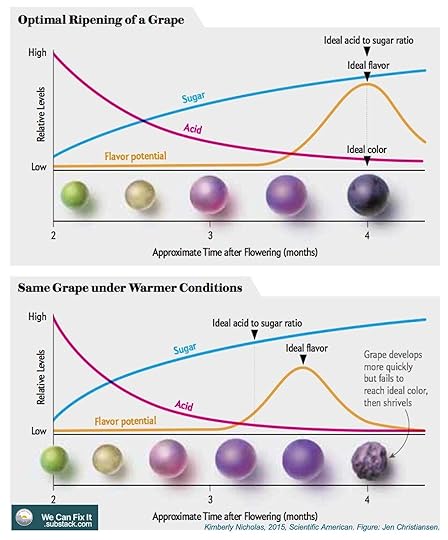 As a grape matures, sugar (blue) rises, acid (red) falls., and flavor (orange) and color build. In ideal conditions, these are in balance. A warmer climate ripens grapes too fast, before flavor and color can peak. Originally published by Kimberly Nicholas in Scientific American (Jan 2015). Graphic credit: Jen Christiansen.
As a grape matures, sugar (blue) rises, acid (red) falls., and flavor (orange) and color build. In ideal conditions, these are in balance. A warmer climate ripens grapes too fast, before flavor and color can peak. Originally published by Kimberly Nicholas in Scientific American (Jan 2015). Graphic credit: Jen Christiansen.Most of what we call taste is actually smell, and climate is changing the aroma compounds in wine as well. Over 1,000 aroma compounds have been identified in wine, and many develop late in ripening and are sensitive to heat. Rotundone, the black pepper note in Syrah, builds best in cooler conditions. So hotter vintages mean blander Syrahs.
At Napa RISE this week, I’m hearing creative strategies to adapt to a warming climate: cover crops, solar panels for vineyard shade (vitivoltaics!), and letting vines sprawl to shade the fruit. There’s also a shift away from the big, jammy wines produced by long “hang time,” towards earlier harvests with a fresher wine style. It’s encouraging to be around people working hard to take care of this beautiful place, and keep great wines on our tables.
Feelings: Enjoy What You HaveThe climate crisis demands a lot from us to meet this moment in history as the last stewards of humanity’s forever carbon budget.
And! We’ve gotta enjoy this one life we get.
To continue to draw strength for doing the climate work, I’m increasingly focused on enjoying the many good moments, while continuing to face hard truths unflinchingly.
On a walk yesterday, I listened to Vicki Robin narrate Your Money or Your Life. In a section called “The Pleasures of Frugality,” she writes:
Frugality means enjoying what we have.
Waste lies not in the number of possessions but in the failure to enjoy them.
To be frugal means to have a high joy-to-stuff ratio. If you get one unit of joy for each material possession, that’s frugal. But if you need ten possessions to even begin registering on the joy meter, you’re missing the point of being alive.
There’s a word in Spanish that encompasses all this: aprovechar. It means to use something wisely, be it a sunny day at the beach, or leftovers made into a delicious new meal. It means getting full value from life, enjoying all the good that each moment and each thing has to offer. You can aprovecha a simple meal, a bowl of ripe strawberries, or a cruise in the Bahamas. There’s nothing miserly about aprovechar; it’s a succulent word, full of sunlight and flavor.
-Vicki Robin, Your Money or Your Life, Chapter 6
What are you making the most of these days? Let me know in the comments.
Action: Write Your Local PaperIs it just me, or has the world gone completely fucking bananas in the last 100 days?
One powerful way to push back to zoom way in. Tell your story of how budget cuts or global geopolitical chaos is affecting YOU or someone you love.
Personal stories shift public opinion, influence leaders, and help change hearts, minds, norms, and culture. In a white paper on the Science of Generosity from the University of California, Berkeley, Summer Allen explains:
“[P]eople are much more likely to help an identified, specific person rather than an abstract or anonymous individual, and they’re more likely to help individuals than groups.”
A study in the United States found more media coverage directly increased public concern for climate change. And elected officials pay close attention to op-eds!
Two effective actions to create media attention:
1. Write an op-ed.Tell your story to your local paper, focusing on why it matters for your community and the climate.
I’ve heard from friends who are facing laying off one of six employees at their small nonprofit, or had approved projects and halfway-completed research trials cancelled. These stories matter. Sharing them builds political pressure for better decisions.
For tips on writing an op-ed, check out this guide from Protect Our Winters for how to write a climate op-ed. A couple highlights:
Keep the everyday reader in mind.
Direct ties to the community in which you are submitting your op-ed are essential.
Come out swinging with clear statements of your opinion and your authority, credibility, or personal experience that supports your opinion.
Remember to argue for "who should do what, when" in your op-ed. (Thanks to David Malakoff, the International News Editor at Science, for this advice!)
A great step-by-step resource for writing and pitching op-eds is the book Youth to Power by Jamie Margolin.
2. Short on time? Write a Letter to the Editor.Write 150 words, directly responding to a recent article published by the paper, connecting it to your perspective and a climate angle.
It would really encourage me to read your op-eds. Please share them with me! You can reply directly to this email to reach me, or share in the comments below.
P.S. Don’t forget to subscribe to your local paper. We need local journalism, and journalism needs us.
Thanks for reading! Please share this post with a friend to spread climate action.
Parting Tidbits Upcoming talks:Tomorrow, May 1: In case you’re in/near Napa right now, come to my talk and panel, “Is Regenerative Ag Our Future?”
I’ll join two in-person events for Lund University Sustainability Week next week:
May 7: A climate movement through bodies in movement, workshop with Nanna Nore at 11:00 at LUCSUS (in Swedish).
May 8: 2040 Starts Now, lecture and film screening, 14:00 at Kalmar Nation.
May 19: Royal Swedish Academy of Sciences Planetary Health Symposium (Invite-only, but get in touch if you’re in Stockholm!)
Recent news“Don’t let perfect be the enemy of good.”
-my advice to the New York Times on “The Best Thing I Can Do For the Planet.”
Book RecommendationWild Dark Shore, by Charlotte McConaghy. I devoured this novel in a couple of days. It’s a tense, compelling story about family, love, trust, ethics, and obligation, and the writing is so beautiful. Asks important questions about the role of people in keeping wild places wild, and how we relate to nature as it gets more volatile. And made me laugh out loud with surprise. SO GOOD!
xo,
Kim
This post is free to make climate action accessible to everyone. Please subscribe to receive new posts. If you find my work valuable and are financially able, I am grateful for any support you can give as a paid subscriber.
March 28, 2025
How transformation happens- and starts in your garden
Hi friends,
From system transformation to existential crisis to frogs and nuts— we’re covering a lot of ground today!
This newsletter is free thanks to support from 107 wonderful paid subscribers- thank you! Your support keeps me going. (If you’d like to join them, scroll to the end.)
Facts: Three Phases of TransformationIn unsettled times, it’s helpful to understand how deep change unfolds.
Top scientists, including the IPCC and IPBES, agree that avoiding climate and ecological breakdown requires not tweaks, but transformational change: “fundamental, system-wide shifts in views, structures and practices.”
Fortunately, there’s science on how to accelerate sustainability transformations. According to the Global Sustainable Development Report,
Transformation happens in three phases, on two tracks at once:
Phasing out the harmful (like fossil fuels and industrial agriculture)
Scaling up the sustainable (like renewables and regenerative farming)
These tracks are mirror images. The new can only rise as the old is dismantled. That’s why it feels like chaos— because it is!
🌱 Phase 1: Destabilization + EmergenceIn the first phase, cracks appear in dominant systems, sometimes triggered by crises. Innovative ideas, tech, and practices begin to emerge on the margins.
Change agents can help tip the balance by using positive levers of change, like:
Governments making smart long-term policy
Investors funding the real economy
Researchers and creatives developing social and technical innovations
People rethinking how we live and what’s possible.
But there are also impediments blocking transformation, like weak policies, lobbying from vested interests, or entrenched practices and behaviors.
It’s a bumpy road, but when levers outweigh impediments, the system can reach a tipping point.
For social change, around 25% of a population can be enough to tip the whole society.
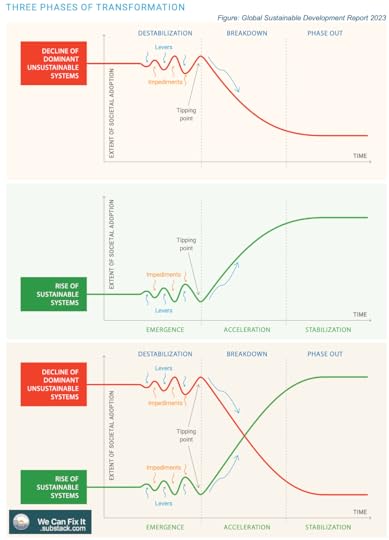 Three phases of transformation: Emergence, acceleration, and stabilization unfold on two tracks: phasing out harmful systems and scaling up sustainable ones. For sustainability to rise, unsustainability must decline. Levers (like policy and innovation) help; impediments (like vested interests) resist. Source: Global Sustainable Development Report 2023.🚀 Phase 2: Breakdown + Acceleration
Three phases of transformation: Emergence, acceleration, and stabilization unfold on two tracks: phasing out harmful systems and scaling up sustainable ones. For sustainability to rise, unsustainability must decline. Levers (like policy and innovation) help; impediments (like vested interests) resist. Source: Global Sustainable Development Report 2023.🚀 Phase 2: Breakdown + AccelerationIn this phase, green alternatives gain momentum. Sustainable technology, institutions, behaviors and norms accelerate and are widely shared and adopted.
Government actions like targets, public infrastructure, standards and regulations, and policies that leave no one behind are often critical.
Meanwhile, harmful systems are breaking down.
Conflicts, tension, and political struggles are common.
The transformation can still fail, from lock-in, backlash, or even system breakdown.
💎 Phase 3: StabilizationIf green systems gain the upper hand, transformation enters the final phase.
Sustainable tech and practices become the new normal in daily life.
Meanwhile, deliberate policies and social shifts continue phasing out the bad stuff.
Yay!
Why this matters for youThis model shows transformation is not only about building something new.
Real change means unbuilding the harmful while nurturing the good.
You can be useful in transformation by supporting emergence (building shared visions, funding or testing a new solution, or shifting your own practice) or by destabilizing the dominant system (like combining carrots and sticks to reduce car use, or supporting the Fossil Fuel Non-Proliferation Treaty).
Transitions aren’t linear. Opposing forces clash at the same time. Knowing how systems transform can help us apply positive levers for change. 💪
This post took time and love to make. If you find it valuable, consider becoming a paid subscriber.
Feelings: Solution to Existential Crisis 🖤Transformation is personal, too. March 9 marked ten years since the death of one of my best friends from college. We threw a heart-filling party to remember and celebrate him. Keep Pubby Weird!!
I went back and read my journal from when he died, and found something I’d written about how he faced his mortality. It still resonated for me:
The solution to existential crisis is to face the truth head on, bravely and unflinchingly, and find a way to keep going. To know all the gory details, and still see what is beautiful amidst all that is not. To not lose hope.
P.S. You can read Pubby’s writing here and here.
 Fort Funston, Golden Gate National Recreation Area. Photo: me Action: Garden for Frogs 🐸 & Nuts 🌰
Fort Funston, Golden Gate National Recreation Area. Photo: me Action: Garden for Frogs 🐸 & Nuts 🌰Getting spring gardening fever? Me too!
Here are two things underway in my garden right now that might inspire yours- and help support biodiversity and yummy climate-friendly food in the process.
1. Build a garden pond 🐸Water is life. And life on earth is in trouble, though we do know how to save it globally.
One humble, local contribution is garden ponds. Studies show backyard ponds can play an important role for urban wildlife, including frogs, birds, insects, and more. As our recent study showed, people need wildlife!
We’re installing a garden pond. I will be very excited if frogs show up!
How to build a simple wildlife pond:Use whatever space you have. Even a small tub or old sink can help. Bigger ponds will attract even more wildlife.
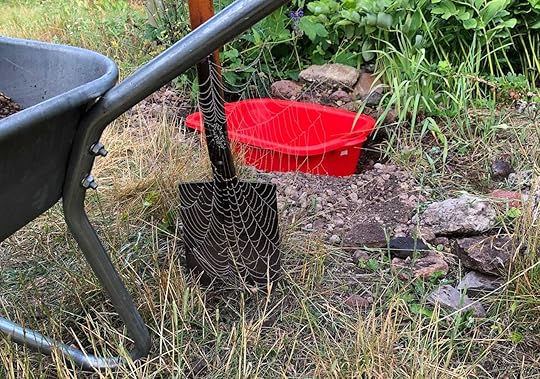 A simple tub, dug into the ground and filled with rainwater and perhaps some native plants, can attract lots of wildlife. Photo: Erik Hansson, RikareTradgard.se
A simple tub, dug into the ground and filled with rainwater and perhaps some native plants, can attract lots of wildlife. Photo: Erik Hansson, RikareTradgard.sePlace it in a mostly sunny spot for maximum biodiversity.
Create depth variety to attract different species.
Use sloped sides, rocks, and entry ramps or logs so critters can safely get in and out. (Fun facts: dragonflies and birds use polarized light, while amphibians use scent!)
Use rainwater, not tap water, which has chemicals sensitive critters don’t like, and nutrients that feed algae growth. We’re currently waiting for more rain to fill our rain barrels!
Let it rewild on its own, if you can. Freshwater Habitats Trust notes this provides distinctive and valuable “young pond” habitat, and is most likely to end up with ecologically suitable species.
If you do want to add plants, stick to native wetland species from your region (within 20km; get landowner permission for collection). (If you just can’t stand waiting for nature to take its course, the Royal Horticultural Society has plant recommendations.)
Don’t add fish. They eat the critters you’re trying to attract, and their eggs!
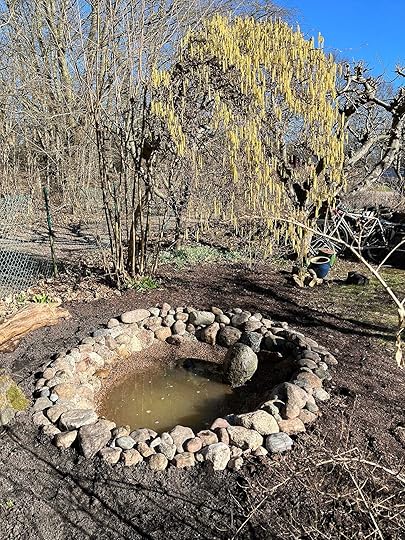 Our in-progress garden pond, with Göran’s newly grafted edible hazelnut tree in the background. Photo: me
Our in-progress garden pond, with Göran’s newly grafted edible hazelnut tree in the background. Photo: me The Wildlife Trusts has a good guide for building a backyard wildlife pond.
2. Plant or graft a nut treeA few weeks ago, a stranger shared a crunchy snack in a bar, and I was hooked.
Fast forward a few weeks, and Göran was in my garden, grafting edible hazelnuts onto the rootstock of our ornamental hazelnut tree. Fingers crossed for homemade Nutella soon!
Why nuts?Nuts are yummy, healthy, and long-storing.
They’re a plant-based protein, which is a high-impact climate action as they basically always beat animal-based options for climate, land, and water impacts.
According to the EAT-Lancet Planetary Health Diet, Europeans should eat 15x more nuts (along with 77% less red meat) for our own health, and that of the planet.
Although people in Sweden have been eating hazelnuts for at least 6,000 years (!!), we don’t grow many locally. Göran and Marijke Christiansson are on a mission to change that, promoting nut cultivation and knowledge from their nursery in Laholm.
Did you know those curly ornamental hazelnuts (which this Purdue University report calls “Contorted Filbert: A Gnarly Problem Plant,” haha) are often rooted on edible hazelnuts? Göran suggested grafting edible shoots onto the existing rootstock. To our knowledge, no one has done this before in Sweden. If it works, we’ll transform our hazelnut into a productive tree!
People have been grafting plant shoots onto the roots of other species to improve crops since at least 300 BC!
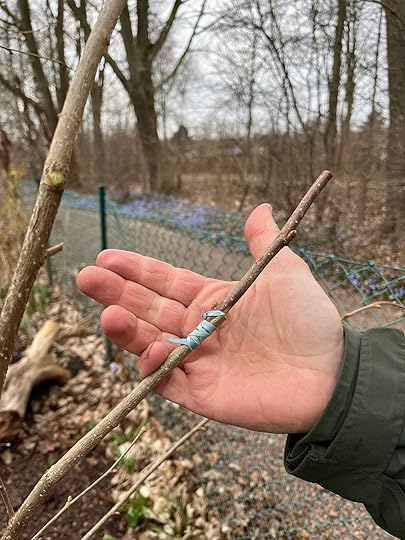 Göran grafted this edible hazelnut onto the rootstock of our decorative hazelnut.
Göran grafted this edible hazelnut onto the rootstock of our decorative hazelnut.If you have garden space:
Plant or graft a nut tree - it’s a delicious, healthy, climate-friendly investment.
Look into hazelnuts, walnuts, almonds, or others, depending on your region.
No garden? You can still choose more plant-based protein, grow more food yourself, and support local growers.
Thanks for reading! Please share this post with a friend to spread climate action.
Parting Tidbits Upcoming talks, come see me here:April 3, Stockholm Resilience Centre
April 8, Royal Scottish Geographical Society, online, personalized climate action
May 1, Napa RISE, regenerative ag
May 7, Lund University, En klimatrörelse genom kroppar i rörelse
May 8, Lund University, 2040 Starts Now
Book RecommendationThe Living Sea of Waking Dreams, by Richard Flanagan. Unsettling, beautiful, and tragic, I inhabited a different world while reading this novel. It’s a bit of magical realism, a healthy portion of unhealthy family dynamics and distraction from what matters, and a lot of love for the natural world.
xo,
Kim
This newsletter stays free to keep climate action accessible to all. If you’re able, becoming a paid subscriber helps me keep it going, and reach more people with evidence-based, actionable advice. Thank you! 💚
February 28, 2025
Localize!
Welcome to We Can Fix It, where we tackle the climate crisis with facts, feelings, and action. Written by me, climate scientist Kim Nicholas.
Hi friends,
Did any of you start working less after my January post? I did! I’m now at 80% time, and enjoying my time off! I do feel more crunched during the work week, and I’ve dropped a few balls (ugh). But I also feel more focused on what matters. On Sunday night, I feel ready to go back to work.
How’s working less going for you? Let me know in the comments!
And now, without further ado: let’s talk about why people need wildlife, not just nature; the feeling of in-person community; and activating locally.
Action: Localize!Whooo boy! Global news is a big fat downer right now, huh??
Local action is a powerful antidote to overwhelm. Start where you are.
The nonprofit Local Futures offers a fabulous Localization Action Guide, with 137 practical actions that can:
🫂 Bring communities together
🍎 Improve human health
🌍 Reduce environmental impact
🤑 Reduce inequality
🗳️ Strengthen democracy
🌱 Connect us with others and the earth.
What is localization?Localization means creating economic structures for communities to meet more of their needs locally. It’s not about isolation or ending trade, but about collaboration.
 The Localization Action Guide from Local Futures.Take action to localize!
The Localization Action Guide from Local Futures.Take action to localize! The Localization Action Guide is packed with practical actions. Here are some I love, especially those that build solidarity. (I had to cut some personal faves, like shipping by sailboat— close to my heart as Simon and I learn sailing from scratch!)
You can sort actions by five groups: individuals, community groups, governments, businesses, and institutions.
Each of six themes has detailed actions, resource links, and case studies where these actions are already working!
ConsumptionMeet real needs, reduce unnecessary consumption.
Practice simple living: Live more on less, celebrate holidays without consumerism, downshift (work less!).
Be part of a gift economy: Participate in a Buy Nothing Group or Really Really Free Markets.
Join a neighborhood sharing network: Borrow and lend tools and resources.
EnergyReduce energy use, ditch fossil fuels, shift to local renewables.
Build community-owned renewable energy: Establish a cooperative “solar garden” for affordable energy for renters and low-income neighbors, or bring locally-owned renewable energy to your community.
Promote car-free towns and cities: Advocate for actions and policies to make your local streets more human-friendly.
FinanceMake the money we save, borrow, and spend serve local communities.
Bank locally: Move your money to a credit union or community bank. (Here’s my breakup letter to my old mega-bank.)
Start a local investing group: Fund community businesses using crowdfunding and local stock exchanges.
CommunityIncrease sense of belonging, support community spaces and local media, engage in local democracy to strengthen bonds with friends, family, and neighbors.
Implement participatory budgeting: Let local residents propose and vote on public investments for local benefit.
Organize a citizens’ assembly: Support local Climate Assemblies for bold action.
Create a neighborhood climate group: Collectively transition away from fossil fuels towards resilient communities.
BusinessSupport local businesses instead of global monopolies, spend money to build stronger local economies, resist corporate globalization.
Shift subsidies from global to local: Push for public funds to support public benefits, including small and local. (You can cite our research showing 40% of EU farm subsidies, over €26 billion a year, are misspent!)
Resist corporate concentration: Join campaigns to fight global corporations, monopolies and big box retail, and strengthen local businesses.
FoodProduce healthy food, provide equitable livelihoods, and support diversity.
Support community land trusts: Preserve farmland and open spaces for generations to come. (Shoutout to my hometown Sonoma Land Trust!)
Start a yard sharing program: Connect homeowners with unused yards to neighbors eager to grow food. You can scale this up to your whole community.
Can these actions really make a difference?I love how Local Futures answers this question:
We think so. Although they are often small and localized, taken together they are vital to recapturing economic democracy from global monopolies. They provide venues for connecting with like-minded others and strengthening the bonds of mutual interdependence. They provide opportunities to reject the monocultural ideas and practices that destroy the beauty and diversity of our planet. And they create "lifeboats" – living hubs of social health, human and ecological wellbeing, and economic resilience – to carry us through the turbulence of the coming decades.
I hope this gets you started! I highly recommend you dive in to the full Localization Action Guide.
Thanks to Local Futures for this incredible resource, and to We Can Fix It reader Elizabeth for sharing it with me!
Thanks for reading! Please share this post with a friend to spread climate action.
Facts: People need wild animals The Problem: Animal Benefits Are InvisibleWhen you close your eyes and picture “nature,” what do you see?
For many, including myself, it’s landscapes: mountains, beaches, forests. Plants, not animals.
The invisible benefits of animals are a problem for international conservation policies, which focus on protecting habitats while overlooking who lives there.
Wildlife isn’t just a cute addition to nature. Animals are essential for ecosystem health and the benefits people rely on.
With wildlife populations in decline, conserving “empty forests” won’t sustain the nature we need.
Our study: Wildlife’s Contribution to PeopleA lunch chat about whale poop sparked our new study, published in Nature Reviews Biodiversity. Led by my friend of 25+ years Becky Chaplin-Kramer, our research analyzed how wildlife supports human well-being.
Using the “nature’s contributions to people” framework — widely used in biodiversity science and policy, and for decision-making in business, investment, and development— we categorized benefits as material (medicines, food), nonmaterial (culture, recreation), and regulating (clean air, healthy soils). Each of these also helps maintain options for future generations.
From a synthesis of scientific reviews, we found wildlife directly supports two-thirds of nature’s contributions to people. We also argue that wildlife support the remaining contributions indirectly, through shaping the ecosystems that provide these contributions.
For example, wildlife benefit people:
materially through food from hunting and fishing and the livelihoods they support.
nonmaterially through art, music, biomimicry, the inspiration of birdwatching, and supporting identities and traditions like catching the first trout of the season.
by regulating healthy ecosystems, like grazers keeping grasslands open and diverse, beavers building dams that can regulate and clean water, and birds eating crop pests.
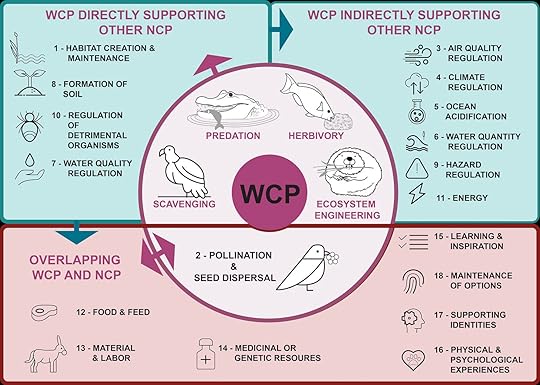 Our new study (Chaplin-Kramer et al., 2025) found wildlife play critical roles in nature’s benefits to people. Wildlife’s contributions to people (WCP) support nature’s contributions to people (NCP) through actions like predation, herbivory, scavenging, and ecosystem engineering. Wild animals directly and indirectly support services such as habitat creation, climate regulation, pollination, food production, and cultural identity. Graphic designed by Sylvia Heredia.Takeaways
Our new study (Chaplin-Kramer et al., 2025) found wildlife play critical roles in nature’s benefits to people. Wildlife’s contributions to people (WCP) support nature’s contributions to people (NCP) through actions like predation, herbivory, scavenging, and ecosystem engineering. Wild animals directly and indirectly support services such as habitat creation, climate regulation, pollination, food production, and cultural identity. Graphic designed by Sylvia Heredia.Takeaways People need wild animals. Scientists need to study them, and policies need to conserve them. The accompanying report by WWF, Nature’s Technicians, concludes:
Wild animals play irreplaceable roles.
Protect remaining wildlife.
Rebuild wild animal populations, especially species that support ecosystem services.
Feelings: In-Person CommunityI spent an evening in a theater packed with people who care about climate action, then had a beer with some of them, and it was life-affirming and lovely!
It was fun and irreverent (yes, a goose puppet named Camelilla bragged, “Why own a car when you can just call a limo?”), but also real and vulnerable, like Nina’s powerful essay on grief. Moments of interaction turned to real conversation and made the stranger next to you feel like a friend.
I joined my first climate protest in 2014 and watched them grow in size and power. In 2019 in Stockholm, the crowd was so massive it took half an hour just to start moving. Goosebumps. But since the pandemic, and increasing restrictions on peaceful protest, I’ve missed the same level of in-person climate energy.
This evening filled my cup and reminded me: nothing replaces meeting people face-to-face. It feels amazing to be surrounded by lots of real people who care. Huge thanks to Maria Wolrath Söderberg, Nina Wormbs, and Isabelle McAllister for making this magical evening happen!
Parting Tidbits Upcoming talks, come see me hereI’ll be online with the Royal Scottish Geographical Society talking personalized climate action April 8, and in-person at Napa RISE on regenerative ag on May 1. Join us!
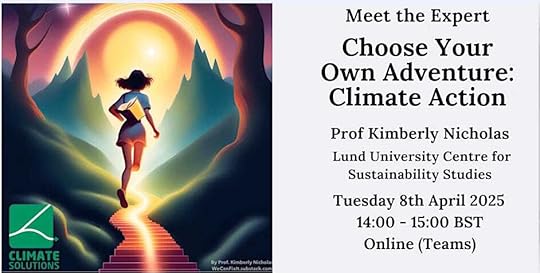
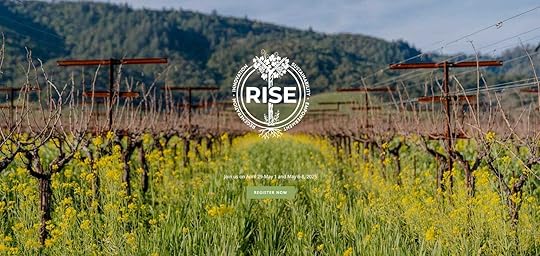
Let me know if you want to collaborate on something for SF Climate Week!
Book RecommendationWhat If We Get It Right? by Ayana Elizabeth Johnson. I loved hearing the voices of deep thinkers and doers in the interviews, who had new ideas on how to bring the climate revolution to the red-state countryside (Brian Donahue), turn extractive fishermen into regenerative ocean farmers (Bren Smith), and offered insights from the youth climate movement (Xiye Bastida). A good counterbalance to the perspectives making headlines right now.
xo,
Kim
This post is free to make climate action accessible to everyone. Please subscribe to receive new posts. If you find my work valuable and are financially able, I am grateful for any support you can give as a paid subscriber.
January 30, 2025
Work Less
Welcome to We Can Fix It, where we tackle the climate crisis with facts, feelings, and action. Written by me, climate scientist Kim Nicholas.
Hi friends, I hope you had peaceful holidays. For me it was a tough end to a tough year. My husband Simon’s dad died unexpectedly two weeks before Christmas. I am grateful for the time we got to spend with family and friends, and now glad to be back home in Sweden. <3
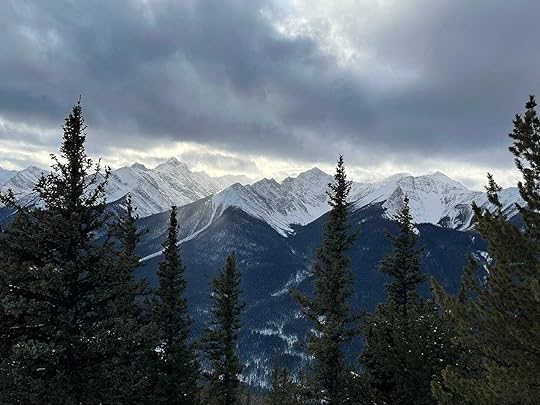 With Simon and his family in Banff National Park for Christmas. Photo: KN
With Simon and his family in Banff National Park for Christmas. Photo: KNOn my mind lately: carbon removal done right, turning worry to compassion, and working less.
Facts: Carbon removal done rightI've long cautioned carbon removal is a limited and risky climate tool. It’s often used today to justify continued pollution and delay the necessary phaseout of fossil fuels. Current offsetting schemes often avoid necessary real reductions. The priority must remain stopping emissions at their source.
So why did I coauthor this new paper on carbon removal?To be clear, at least 90% of our efforts, funding, and attention must be on eliminating emissions at their source. As we wrote in our paper led by Jan Mertens, “Carbon dioxide removal technologies should be considered once efforts have already achieved a >90% reduction in emissions.”
However, carbon removal will likely play *some* role to stabilize the climate. To stop warming, humans have to stop adding CO2 to the atmosphere. To achieve this, any remaining hardest-to-cut, last <10% emissions will have to be removed.
And we’ll need to take carbon out of the atmosphere if we want to return to a safer climate, from today’s already-dangerous 425 parts per million CO2 and rising, to reach a goal like 350 ppm.
This means targeted carbon removal must be done right.
Assessing risks and benefits of carbon removalIn our new study, we evaluated 16 carbon dioxide removal strategies, from natural solutions like planting forests to building machines to suck carbon out of the air. While many studies focus on technical effectiveness, neglecting risks and social implications, we assessed these strategies on four dimensions:
1. Environmental, Social, and Governance (ESG) scoreThe author team rated each strategy on:
Environmental benefits (e.g., improved soil quality, biodiversity protection)
Environmental integrity (e.g., risk of ecosystem disturbance, biodiversity risk)
Social acceptance (e.g., greenwashing risks, fairness in project siting)
Governance preparedness (alignment with existing policies and regulations)
2. Time scale of carbon storageBecause carbon is forever, any useful attempt to neutralize fossil carbon has to last essentially forever.
We categorized carbon removal strategies into three durability levels:
Short-term (<100 years): Forests, soils and ocean ecosystems. These can help neutralize short-lived methane and land-use emissions, but don't provide lasting storage for fossil fuel emissions.
Medium-term (100-1,000 years): Biochar and some ocean-based technologies.
Long-term (>1,000 years): Geological, “permanent” carbon dioxide removal and storage, like from direct air carbon capture and storage (DACCS). Long-term strategies are the only ones that credibly neutralize fossil CO2 emissions. Less durable storage still leads to warming, as this recent paper showed; see ’s excellent post from Climate Brink.
We combined ESG and durability into a Quality score (see X-axis below).
3. Technical potentialHow much CO2 (gigatonnes per year) could each approach remove by 2050?
Our estimates are based on existing scientific literature.
Shown on the Y-axis below.
4. Technology readiness levels (TRL)We assigned a score from 1 to 9 for each technology’s maturity:
1: Basic principles observed.
9: Actual system proven in operation today.
Shown by colors from red (low) to high (green) in the graph below.
Rating carbon removal qualityOur findings highlight direct air capture (DACCS) as one of the highest-quality carbon removal options, with high ESG ratings, long-term durability, and fairly high technical potential. Other promising but shorter-term strategies include reforestation, building with wood materials, biochar, and soil carbon storage. In contrast, ocean-based approaches were rated of lower quality due to high uncertainties and risks to ocean ecosystems.
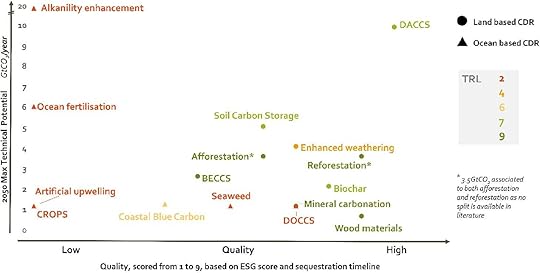 Rating 16 strategies for carbon removal based on quality (combining ESG factors and storage durability), effectiveness (potential gigatons of CO2), and technical readiness level (TRL). Strategies to the upper right corner are the best. Darker green strategies are most technically ready. Source: Mertens et al., 2024. Feelings: Turn Worry to Compassion
Rating 16 strategies for carbon removal based on quality (combining ESG factors and storage durability), effectiveness (potential gigatons of CO2), and technical readiness level (TRL). Strategies to the upper right corner are the best. Darker green strategies are most technically ready. Source: Mertens et al., 2024. Feelings: Turn Worry to CompassionA few weeks ago, I was on a beautiful walk but stuck in a loop of worry— rehashing an unhelpful conversation with one of my dad’s doctors. I suddenly realized I was missing out on the sunlight and birdsong around me, trapped in thoughts that weren’t useful.
That’s when two ideas from 10% Happier by Dan Harris popped into my head.
1. Ask “Is this useful?”Harris suggests this question to distinguish between productive thinking, planning, and problem-solving, vs. repetitive, draining worry. My ruminations were not helping. I’d already helped take the next steps needed for my dad’s care. There was nothing more I could do in that moment.
2. Wish people wellI realized my un-useful worry was rooted in something important, namely my love and care for my dad. Instead of spiraling in my worry, I directed that energy towards another practice from 10% Happier (which Dan Harris classified as “Things I Will Definitely Hate” the first time he tried it).
Picture someone in your mind and silently wish them well:
May you be happy.
May you be safe.
May you be healthy.
May you live with ease.
Thinking these positive thoughts for my dad felt SO much better than taking one more run down the well-worn ski tracks of what-ifs in my mind.
Encouraged, I followed Dan’s advice to think of other people and send them the same well-wishes.
First I thought of “a neutral person, someone you see regularly, but tend to overlook. Your barista, a janitor in your building, a neighbor who doesn’t provoke much of an emotional charge,” as Harris wrote.
It was easy for me to generate good vibes for the smiley desk clerk at the gym whose name I don’t know.
Then, a bigger challenge: a difficult person. As I brought to mind people I struggle with and wished them well, I realized how far they were from happy, healthy, and living with ease. This made me feel more compassion for what they were going through, instead of focusing on my own annoyance.
Why This WorksThe well-wishing practice is a form of loving-kindness meditation (metta) from Buddhism. I like what Dan Harris writes about it:
“This practice can seem forced and treacly, but the research suggests it can have significant physiological, psychological, and even behavior benefits. The upshot is radical: just as happiness is a skill, so is love.”
Next time you find yourself stuck in a loop of worry, try asking, “Is this useful?” If not, instead of spinning in circles, direct that energy to compassion for someone in the worrying situation - including yourself.
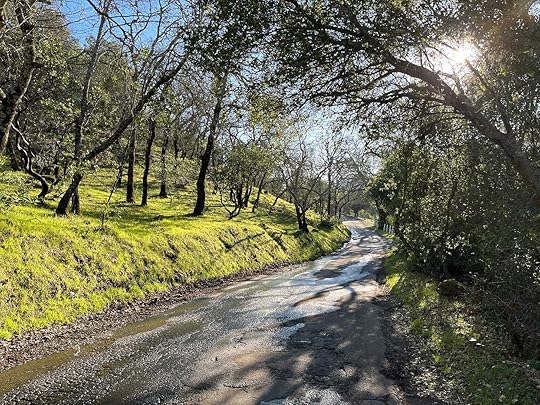 The view I was missing out on stuck in a loop of unhelpful worry. I appreciated it a lot more after I turned that worry towards compassion.Action: Work Less Rethinking Time
The view I was missing out on stuck in a loop of unhelpful worry. I appreciated it a lot more after I turned that worry towards compassion.Action: Work Less Rethinking TimeIn my beloved Politics & Philosophy book club, we just read “How Much Is Enough? Money and the Good Life.” It sparked a discussion about working less.
My relationship with time is changing. I used to focus on optimizing time, squeezing maximum productivity out of every minute. But that approach started to feel relentless, even joyless.
Now, I see time as something I experience, not just spend. I want to enjoy that experience (namely, the moments that add up to being my actual life!).
There’s a lot I enjoy and find meaningful in my work — helping students, contributing to climate solutions. But there’s also a lot outside of work that matters. Increasingly, time feels more precious to me than money.
The Case for Working LessSeveral of my friends have already chosen to work 80% time. Their motivations vary: health, family, volunteering, hobbies. They all love it.
And there are substantial climate benefits to working less:
A systematic review led by Miklós Antal found consistent evidence that reducing paid work time reduced greenhouse gas emissions.
Martin Pullinger’s research found policies that reduced work hours 20% or enabled 3 month career breaks would reduce national emissions by 3-4.5%.
A Swedish study found working 1% less led to an 0.8% drop in greenhouse gas emissions (higher reductions for wealthier households). They recommended gradual reduction to a 30 hour work week.
The main reason working less helps the climate is that earning less money lowers consumption (rather than ). Higher incomes drive higher-carbon lifestyles.
Of course, not everyone can afford to work less. But those of us in the top 10% globally are the ones who need to shrink our footprints anyway! Low-income folks emit very little already.
An inspiring auto-replyMy friend Diana Ivanova, a lecturer at Leeds University, has the best email auto-reply. She generously gave me permission to share it with you here (I’ve modified and embedded the links):
How to work less
Hi there,
I am working four days a week and will get back to you next week. The reason for that is that working less has various social and environmental benefits* that are worth exploring more.
I definitely recommend you try it out if you have the possibility!
*Some references on how working less may help:
Reduce greenhouse gas emissions and energy use
Reduce income inequality and gender imbalances in the distribution of paid work, and sustain employment
Improve health and reduce overconsumption of food [by replacing work with sleep!]
Contribute to personal, family and community well-being and decrease the importance of materialistic values
Best wishes,
Diana
Not all reduced work schedules have the same climate benefits. A UK study found:
✅ Best option: Three-day weekends—closing offices on Fridays saved the most emissions.
✅ Good options: Free Wednesdays or coordinated work reductions (e.g., hot desking) also helped reduce emissions.
❌ Worst options: Shorter workdays (same commuting + offices stay open, same energy use) and increased paid vacation time (more climate-intensive air travel).
The more people work less, the greater the climate benefits, especially if employers coordinate their resources efficiently.
Maybe your next water cooler chat with colleagues (or your boss!) should be about working less? I’m going to give it a try!
P.S. Recommended reading that influenced my thinking about valuing time: Four Thousand Weeks, Your Money or Your Life, Momo, Die with Zero.
Thanks for reading! Please share this post with a friend to spread climate action.
Parting Tidbits Upcoming talksI’ll join the wonderful Maria Wolrath Söderberg and Nina Wormbs at Palladium in Malmö on February 11 at 19h for Omställningsont: Bråkshow om att vara människa i klimatkrisens tid (in Swedish). Tickets here.
Recent newsI talked with the BBC about the lowest carbon alcohol.
Book Recommendation10% Happier, by Dan Harris. A refreshingly snarky, honest page-turner that doesn’t take itself too seriously. Harris is quite convincing in his claim that meditation can make you 10% happier. The book doesn’t directly tackle climate, but I found many of the lessons incredibly relevant (like striving for wisely ambitious goals, without being too attached to outcomes out of your control).
xo,
Kim
November 28, 2024
How to free your bandwidth for what matters
Welcome to We Can Fix It, where we tackle the climate crisis with facts, feelings, and action, written by me, climate scientist Kim Nicholas.
Hi friends, this month I’m sharing our new rural report card for European agriculture, feeling resolute in a global leadership vacuum, and questioning my relationship with social media.
Facts: Food vs. people and planet?To achieve a climate-safe and sustainable world, we must measure and incentivize sustainability outcomes, like reducing greenhouse gas emissions and protecting high-nature value farmland.
Measuring outcomes is essential because it tracks progress and holds policymakers accountable. But too often, analyses focus on actions (like applying fertilizer), without examining their effects. (That’s why I focus on high-impact climate actions!)
In my research, I aim to connect policies and practices with measurable outcomes that assess their effectiveness.
In our new open-access study, Murray Scown and I identified rural regions in Europe that contribute positively to sustainability goals (“brightspots”), and those hindering progress (“dragspots”).
We used hotspot analysis of 24 social and environmental indicators, drawn from the overlap of the EU Sustainable Development Goals (SDGs) and the Common Agricultural Policy (CAP)— the EU’s €59 billion farm subsidy program and largest budget item.
Here’s what we found:
1. The EU pays a high price to support unsustainable land systems.Dragspots, regions with poor social and environmental outcomes, often receive high subsidy support. This means public money is paying for “bads” like social inequities and environmental harm.
Some good news: environmental subsidies do work. High-performing environmental regions benefitted from this targeted support.
2. Tradeoff between food production and sustainable outcomes :(The least sustainable regions were doing one thing right: producing a high fraction of food for people. This highlights a major tradeoff in European agriculture: high food production currently comes at high environmental cost. We can do better.
Globally, only 55% of food directly feeds people; the rest is used inefficiently for animal feed (36%) or biofuels and industry (9%).
3. Brightspots: Nordics and Central EuropeTwo brightspot regions stood out for their contributions to social and environmental sustainability goals: the Nordics (Sweden + Finland) and Central Europe (Germany, Austria, eastern Switzerland). These areas benefit from less intensive farming practices, including organic agriculture, low energy use in farming, supported by robust agricultural training, providing high farm employment and income.
We found five dragspots where rural land use is hindering progress towards the SDGs: the Lowlands, Northern Italy, Southern Italy and Malta, Southern Spain, and the Balkans. Dragspots were characterized by intensive agriculture with high inputs of irrigation, pesticides and fertilizers, as well as very large, industrial animal agriculture such as in the Lowlands and Northern Italy.
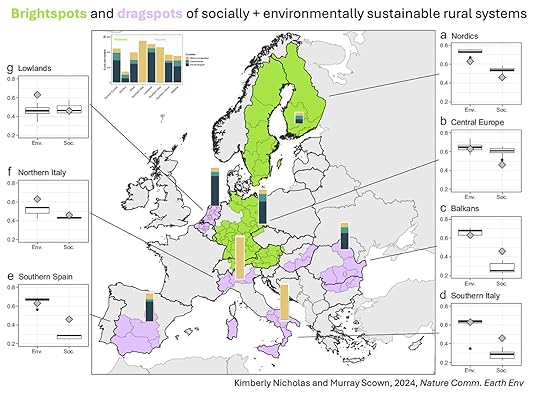 Two hotspots (green) and five dragspots (purple) of sustainable rural land systems in Europe, based on their performance on 24 social and environmental indicators. Dragspots tend to receive high CAP subsidies, yet deliver poor sustainability outcomes. The median and interquartile range (box) is compared to the mean score across all regions (grey diamonds). The inset shows subsides paid from the Common Agricultural Policy for income support (navy), environmental (green), or other (yellow) for each hotspot. Source: Figures 3 + 4 in Nicholas and Scown, 2024 The path forward
Two hotspots (green) and five dragspots (purple) of sustainable rural land systems in Europe, based on their performance on 24 social and environmental indicators. Dragspots tend to receive high CAP subsidies, yet deliver poor sustainability outcomes. The median and interquartile range (box) is compared to the mean score across all regions (grey diamonds). The inset shows subsides paid from the Common Agricultural Policy for income support (navy), environmental (green), or other (yellow) for each hotspot. Source: Figures 3 + 4 in Nicholas and Scown, 2024 The path forward Our research suggests the following steps to transition to sustainable food systems:
Measure sustainability using social and environmental outcomes tied to policy goals.
Shift subsidies to reward positive social and environmental outcomes.
Support low-input, sustainable farming for its multiple benefits.
Explore case studies where generous food production is balanced with good sustainability outcomes.
Read the study here, if you like.
Feelings: ResoluteI’ve been feeling… kind of a lack of feeling… about some pretty monumental events this fall: the American elections, the United Nations conferences on climate and biodiversity. These are important moments, things are not going great, and yet my response is… meh? 🤷♀️
Right now, I don’t feel panic or despair. I know climate work is still needed and it still matters. This will continue to be true for the rest of my life.
In what I hope is being resolute and clear-eyed and constructive, but may also be tinged with cynicism, I increasingly accept in my bones that no one is coming to save us. As I wrote in Under the Sky We Make,
We as humanity, a groundswell of people alive today around the world, have to save ourselves, through what we think and feel and ultimately what we do. This means we need people with the courage and compassion and imagination to transform themselves, and society, in the ways that science tells us are necessary to maintain conditions for life on Earth to be able to thrive. Each of us can become that sort of person; more and more are every day.
Real leadership - climate and otherwise- may not emerge from the top. In the past, I’ve felt shattered by global circumstances going in the wrong direction. Right now, I just feel resolute to keep doing what I can, where I can. Thanks for being on Team Climate.
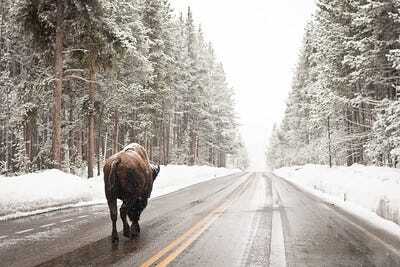 A resolute bison keeps putting one foot in front of the other. Image: Jess J on Flickr Action: Reassess Social Media
A resolute bison keeps putting one foot in front of the other. Image: Jess J on Flickr Action: Reassess Social Media Ah, social media, that double-edged sword.
On the positive side, social media can shape cultural norms and help set policy agendas, including for climate action. But social media can also spread climate misinformation (unintentionally incorrect) or disinformation (deliberately misleading), contribute to increasing polarization, and disproportionately amplify negative messages.
As a very active user of social media professionally, I’ve gained valuable connections, ideas, and community. But over the last couple of years, especially now that Climate Twitter has become, as Katharine Hayhoe told Science last week, a “ghost town,” I’ve been reconsidering how and when I use social media.
Instead of hot takes, I crave deeper, slower, more thoughtful and nuanced analysis and reflection. Reading more longform journalism and books, and spending more time in the real world (connecting with people, going for walks, paying attention while cooking) feels better for me right now.
 Source: Bayo Akomolafe, “A Slower Urgency”
Source: Bayo Akomolafe, “A Slower Urgency”I want to save the precious, limited bandwidth of my mind and attention for what matters and where I can make a contribution. Five years later, I’m still haunted by the hour-long yoga class I ruined by ruminating over a comment from A Stranger on the Internet Who Was Wrong.
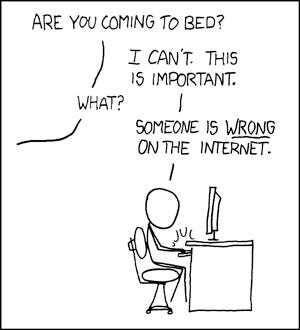 From the genius that is Randall Munroe, XKCD
From the genius that is Randall Munroe, XKCD I’m also increasingly uncomfortable with the idea of donating my unpaid labor - writing original material, as well as clicking on platforms - to further enrich billionaires with dubious motives.
My evolving strategy is to spend more time writing original longer “content” (cringe) here on Substack, sharing excerpts on social platforms, and slowly keep working on a new book.
I appreciate that you, dear reader, have chosen to join We Can Fix It and to share your email with me, so we can stay connected regardless of what happens to these platforms. So thanks for being here. <3
For your climate action this month, I encourage you to consider your relationship with social media.Some options to consider, to whatever extent works for you right now:
Remove social media apps from your phone.
Try a social media fast (a week? a month?).
Set time limits for apps using tools like Screen Time for iPhone or Digital Wellbeing for Android.
Follow those who spark your curiosity and energy. Block those who don’t.
Choose when and how you engage, and the kinds of conversations you want to contribute to.
Charge your phone outside your bedroom to avoid late-night distractions. (This has helped me sleep better and double the number of books I read!)
What will you do with the time and energy you free up? That’s up to you! A few suggestions:Take high-impact climate action with the Choose Your Own Climate Adventure Guide.
Enjoy time in nearby nature, and take care of your local patch.
Find your climate peeps — people you have fun with, including while talking about and taking climate action.
Join and support local climate action groups- here’s how to get started.
Read more books and in-depth journalism, like my recommended climate media.
Thanks for reading! Please share this post with a friend to spread climate action.
Parting Tidbits Upcoming talks:Join in person or online on December 12 for a seminar and workshop on sustainable agriculture in a changing climate, hosted by Université Laval in Quebec City.
 Book Recommendation
Book Recommendation Limitarianism: The Case Against Extreme Wealth, by Ingrid Robeyns. I really enjoyed reading this clearly argued book, making the philosophical case for setting an upper limit on wealth for the sake of people and climate. Definitely a thought-provoking holiday gift!
Take care friends, have safe and peaceful holidays. I’ll be back here in January, look forward to seeing you then!
xo,
Kim
P.S. I met my goal of 1,000 hours outside for 2024! Actually I’m ahead of schedule, I’m now at 1,125 and counting! I really enjoyed finding more ways to be outside, and hope to continue. Highly recommend for 2025!
This post is free to make climate action accessible to everyone. Please subscribe to receive new posts. If you find my work valuable and are financially able, I am grateful for any support you can give as a paid subscriber.
October 31, 2024
87.5% screwed
Hi friends!
This month, we’ll explore the safe and just space for humans on Earth; how to turn a gnawing rat of avoidance into a fluffy white sheep of possibility; and democratic principles for doing the work to build the world we want.
Facts: We’re 87.5% screwedWe’re in trouble: humanity has crossed seven out of eight global thresholds needed to keep Earth stable and provide a good life for all, according to the Earth Commission report. Eeek!
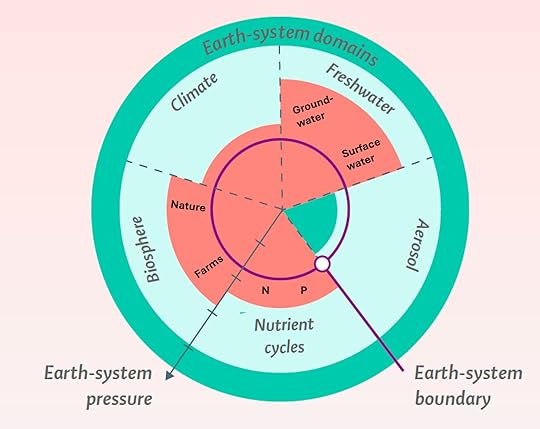 Current status of eight Safe and Just Earth System Boundaries, where seven of eight are in the red danger zone. Source:
Lancet infographic
based on Gupta et al., 2024. I added the boundary names in bold (e.g, N, P).
Current status of eight Safe and Just Earth System Boundaries, where seven of eight are in the red danger zone. Source:
Lancet infographic
based on Gupta et al., 2024. I added the boundary names in bold (e.g, N, P). Climate, groundwater depletion, surface water overuse, nitrogen and phosphorous pollution, land for nature, and natural vegetation within human-dominated landscapes are all in the danger zone. Only particulate air pollution (aerosols) hasn’t crossed global limits, though it’s over the line in some regions.
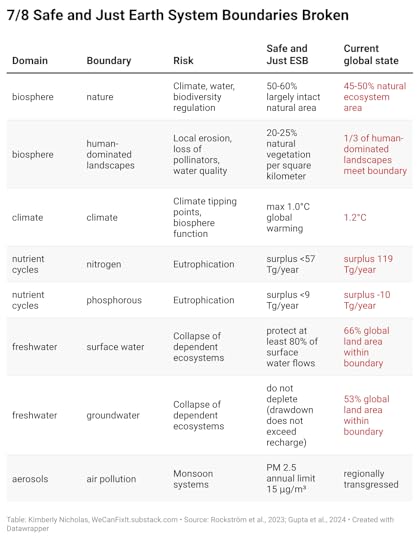 The eight Earth System Boundaries, the risks from breaking them, the safe and just boundary threshold, and the current global state. Boundaries over the limit are shown in red. Source: My own visualization from data in Rockström et al., 2023 and Gupta et al., 2024
The eight Earth System Boundaries, the risks from breaking them, the safe and just boundary threshold, and the current global state. Boundaries over the limit are shown in red. Source: My own visualization from data in Rockström et al., 2023 and Gupta et al., 2024This study builds on work dating back 15 years, including the inspiration for this gem:
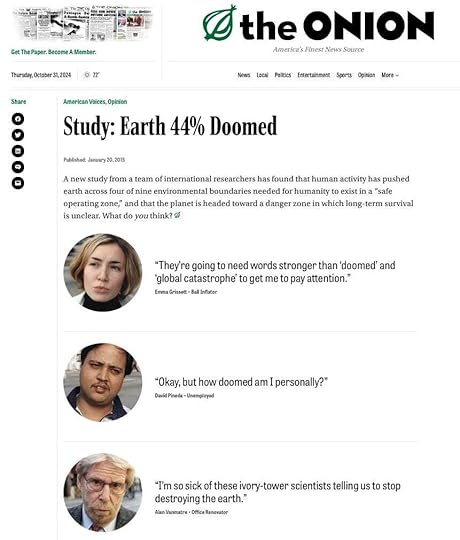 Possibly my favorite piece from The Onion, in response to the 2015 Planetary Boundaries study. Needs above the floor, pressure below the ceiling
Possibly my favorite piece from The Onion, in response to the 2015 Planetary Boundaries study. Needs above the floor, pressure below the ceiling Scientists created these “safe and just Earth System boundaries” by combining the planet’s biophysical limits (the ceiling) with meeting everyone’s basic needs (the floor).
The goal is the green zone, where all people have access to minimum needs for food, water, energy, and infrastructure, without putting too much pressure on Earth systems.
The just zone means sharing resources fairly among species (who all need a stable planet), across generations, and among today’s communities.
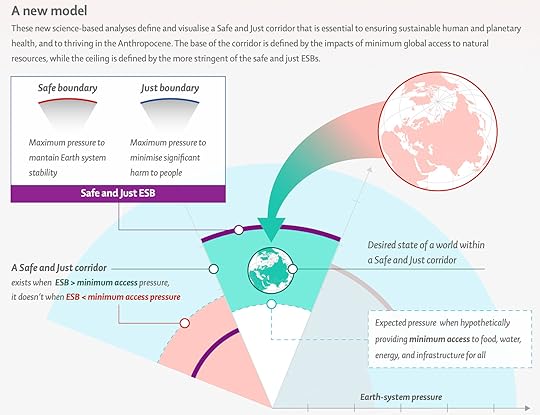 Safe and Just Earth System Boundaries are met when all people have basic needs met, within a stable Earth system. Source: Lancet infographic based on Gupta et al., 2024. Solutions: Reduce and redistribute; align the economy with justice; expand sustainable tech
Safe and Just Earth System Boundaries are met when all people have basic needs met, within a stable Earth system. Source: Lancet infographic based on Gupta et al., 2024. Solutions: Reduce and redistribute; align the economy with justice; expand sustainable tech To get to the safe and just space, the Earth Commission suggests three main solutions:
Reduce and reallocate consumption: cut waste and set limits on harmful overuse, while ensuring everyone has what they need.
Transform the economy: Align markets with sustainability and justice by factoring in environmental costs, and stopping harmful subsidies and investments.
Expand sustainable tech: Make efficient, affordable tech available worldwide to create a circular, low-impact economy.
P.S. I’m working on solutions that will get us to the Safe and Just space- stay tuned!
Feelings: “Befriend your gnawing rats”You know the things you’re avoiding because they make you anxious to think about? Like the cluttered garage you never get around to cleaning… or the nagging health concern you keep putting off… or, you know, taking meaningful climate action??
The wise-but-not-treacly Oliver Burkeman, in Meditations for Mortals, has great advice for facing these stressors, borrowing a vivid metaphor from Paul Loomans, who calls them “gnawing rats.”
Instead of the usual advice to attack the problem head-on, or break tasks into smaller parts, Burkeman advises to start by accepting the rats’ existence.
It’s a gentler approach based on accepting reality as it already is, and turning towards the gnawing rats:
Some ways to befriend your gnawing rats, thanks to Burkeman:
“[T]o befriend a rat is to defuse the anxiety you feel by transforming the kind of relationship you have with it… You turn it into an unobjectionable part of your reality. Whereupon a gnawing rat, in Looman’s terminology, becomes a ‘white sheep’— a harmless, docile, fluffy creature that follows you around until you decide to do something about it.”
—Oliver Burkeman, Meditations for Mortals
Take the easiest step forward: Find the least intimidating way to begin.
Ask for help: Your gnawing rats may be someone else’s harmless white sheep- and they likely have some of their own rats you could help them with.
Visualize getting started: Close your eyes and picture yourself taking action.
“Just go to the shed”: Visit the space that’s making you anxious and guilty, have a look around, and let the first solutions reveal themselves.
Do something you can actually do today: If an hour of work sounds overwhelming, could you tolerate half an hour? 15 minutes? 10?? (At my low point in writing my dissertation, I had to start with 10-minute writing sessions. It did eventually get written. I also like to set a 5 minute timer to start a task I don’t wanna do; usually I have enough momentum to continue from there once I’ve started.)
What small step could you take today to start befriending one of your gnawing rats?
P.S. Remember the 5 Stages of Climate Feelings— avoidance is #2, and the way from Doom to Purpose is via All the Feels!
Action: How to Organize DemocraticallyThere’s a lot of important and urgent work to do. How do we work well within teams and communities to make lasting progress?
Thankfully, nearly 30 years ago, environmental justice leaders developed the Jemez Principles for Democratic Organizing, which can help us organize in a fair, inclusive, and effective way. Here’s a brief summary:
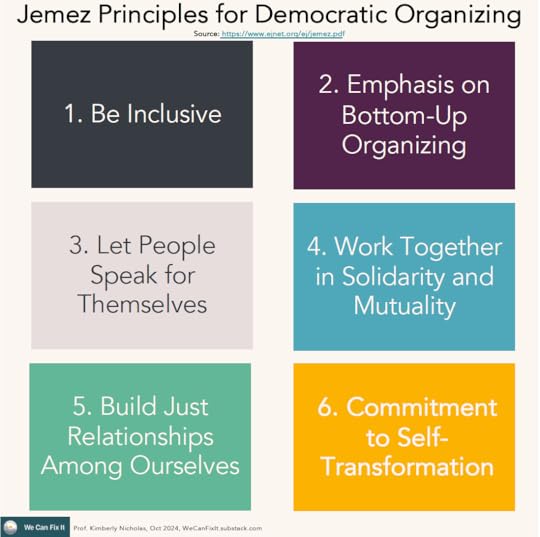 The Jemez Principles of Democratic Organizing. Source: https://www.ejnet.org/ej/jemez.pdf Jemez Principles for Democratic Organizing
The Jemez Principles of Democratic Organizing. Source: https://www.ejnet.org/ej/jemez.pdf Jemez Principles for Democratic Organizing (This is a selected summary; full text here.)
1. Be inclusive.Build inclusion into your movement, going beyond tokenism to include diversity throughout planning and action. It might take more time and effort, but it’s essential.
2. Emphasis on Bottom-Up OrganizingReach out to new groups, and strengthen your existing base. Building a strong grassroots foundation gives your movement credibility, strategy, and “the energy for the work we must do daily.”
3. Let People Speak for Themselves“We must be sure that relevant voices of people directly affected are heard.” Community spokespeople should be genuine representatives. Assure accountability.
4. Work Together in Solidarity and MutualityCollaborate with groups whose visions align with yours, and support each others’ work. Ultimately, integrate their goals and values in your own work. For example, a labor union including environmental goals in their own strategies, rather than just supporting environmental organizations.
5. Build Just Relationships Among OurselvesTreat everyone with respect and fairness, within and across organizations. This includes being transparent about decisions, sharing resources, and ensuring equitable strategies.
6. Commitment to Self-Transformation“We must ‘walk our talk.’ We must be the values that we say we’re struggling for.”
What parts of your work could benefit from these principles? Have you found other effective ays to run fair and inclusive processes? I’d love to hear your thoughts- feel free to share n the comments below, or by reply to this email!
Thanks for reading! Please share this post with a friend to spread climate action.
Parting Tidbits Upcoming talks, come see me here:Extreme Wealth and Climate Inequality: If you’re in Lund, join us on November 20th at 18:00 for a lecture from philosophy professor Ingrid Robeyns and discussion panel on her new book “Limitarianism: The Case Against Extreme Wealth.”
Recent podcast:I discussed what the US election means for global climate, and answer listener questions about China’s emissions and 1.5°C. Listen from 18:00-27:30:
Book Recommendation:American Mermaid, by Julia Langbein. A wild and surreal novel about staying sane and principled in a world that increasingly isn’t. Felt pitch-perfect for this moment. I want to live in a world where fierce mermaids take on evil technocrats destroying the climate!
Thanks for reading. Take care, friends!
xo,
Kim
This post is free to make climate action accessible to everyone. Please subscribe to receive new posts. If you find my work valuable and are financially able, I am grateful for any support you can give as a paid subscriber.



